Birka
Birka ![]()
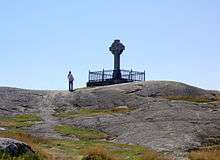 Ansgars Cross in Birka | |
| Location | Ekerö Municipality, Sweden |
|---|---|
| Coordinates | 59°20′10″N 17°32′43″E |
| History | |
| Founded | 8th century |
| Abandoned | 10th century |
| Periods | Viking Age |
| Official name | Birka and Hovgården |
| Type | Cultural |
| Criteria | iii, iv |
| Designated | 1993 (17th session) |
| Reference no. | 555 |
| State Party | Sweden |
| Region | Europe and North America |
Birka was founded around AD 750 and it flourished for more than 200 years. It was abandoned c. AD 975, around the same time Sigtuna was founded as a Christian town some 35 km to the northeast. It has been estimated that the population in Viking Age Birka was between 500 and 1000 people.[1]
The archaeological sites of Birka and Hovgården, on the neighbouring island of Adelsö, make up an archaeological complex which illustrates the elaborate trading networks of Viking Scandinavia and their influence on the subsequent history of Europe. Generally regarded as Sweden's oldest town,[2] Birka (along with Hovgården) has been a UNESCO World Heritage Site since 1993. A silver ring from a Viking-era grave in Birka is the first ring with Arabic inscription from that era found in Scandinavia.[3]
History
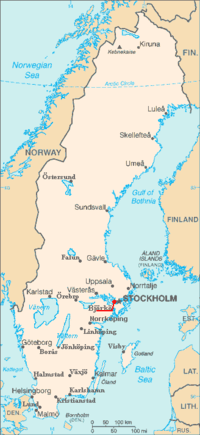
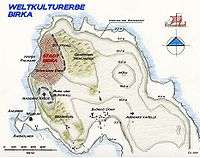
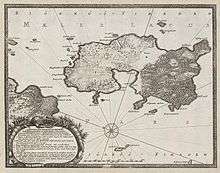
Birka was founded around AD 750 by either a king in order to control and expand trade or it emerged from a seasonal trading place around.[1] It is one of the earliest urban settlements in Scandinavia. Birka was the Baltic link in the river and portage route through Ladoga (Aldeigja) and Novgorod (Holmsgard) to the Byzantine Empire and the Abbasid Califate.[4] Birka was also important as the site of the first known Christian congregation in Sweden, founded in 831 by Saint Ansgar.
As a trading center Birka most likely offered furs and iron goods as well as craft products, in exchange for various materials from much of Europe and western Asia. Furs were obtained from the Sami, Finns, and people in northwestern Russia as well as from local trappers. Furs included bear, fox, marten, otter, beaver and other species. Reindeer antler was an important item in exchange as well as hand-carved combs made from antler. Also walrus teeth, amber, and honey were exchanged.
Foreign goods found from the graves of Birka include glass and metal ware, pottery from the Rhineland, clothing and textiles including Chinese silk, Byzantine embroidery with extremely fine gold thread, brocades with gold passementerie and plaited cords of high quality. From the ninth century onwards coins minted at Haithabu in northern Germany and elsewhere in Scandinavia start to appear. The vast majority of the coins found at Birka are however silver dirhams from the Caliphate. English and Carolingian coins are rare.[1]
Sources of Birka are mainly archaeological remains. No texts survive from this area, though the written text Vita Ansgari ("The life of Ansgar") by Rimbert (c. 865) describes the missionary work of Ansgar around 830 at Birka, and Gesta Hammaburgensis Ecclesiae Pontificum (Deeds of Bishops of the Hamburg Church) by Adam of Bremen in 1075 describes the archbishop Unni, who died at Birka in 936. St Ansgar's work was the first attempt to convert the inhabitants from the Norse religion to Christianity, and it was unsuccessful.
Both Rimbert and Adam were German clergymen writing in Latin. There are no known Norse sources mentioning the name of the settlement, or even the settlement itself, and the original Norse name of Birka is unknown. Birca is the Latinised form given in the sources and Birka its contemporary, unhistorical Swedish form. The Latin name is probably derived from an Old Norse word "birk" which probably meant a market place. Related to this was the Bjärköa law (bjärköarätt) which regulated the life on market places in Denmark, Norway and Sweden. Both terms in different forms are very common in Scandinavian place names still today leading to speculation that all references to Birca especially by Adam of Bremen were not about the same location.
Both publications are silent on Birca's size, layout and appearance. Based on Rimbert's account, Birca was significant because it had a port and it was the place for the regional ting. Adam only mentions the port, but otherwise Birca seems to have been significant to him because it had been the bridgehead of Ansgar's Christian mission and because archbishop Unni had been buried there.
Vita Ansgari and Gesta are sometimes ambiguous, which has caused some controversy as to whether Birca and the Björkö settlement were the same location. Many other locations have been suggested through the years.[5] However, Björkö is the only location that can show remains of a town of Birca's significance, which is why the vast majority of scholars regard Björkö as the location of Birca.[6]
Birka was abandoned during the later half of the 10th century. Based on the coin finds, the city seems to have silenced around 960.[7] Roughly around the same time, the nearby settlement of Sigtuna supplanted Birka as the main trading centre in the Mälaren area.[8] The reasons for Birka's decline are disputed. A contributing factor may have been the post-glacial rebound, which lowered the water level of Mälaren changing it from an arm of the sea into a lake and cut Birka off from the nearest (southern) access to the Baltic Sea. The Baltic island of Gotland was also in a better strategic position for Russian-Byzantine trade, and was gaining eminence as a mercantile stronghold.[8][9] Historian Neil Kent has speculated that the area may have been the victim of an enemy assault.[8]
The Varangian trade stations in Russia suffered a serious decline at roughly the same date.
Rimbert's description
In Vita Ansgari ("The life of Ansgar")[10] monk and later archbishop of Hamburg-Bremen Rimbert gives the first known description of Birka. The town was the center of Catholic missionary activities in the 9th century Sweden. Rimbert's interests were in the Christian faith, not so much in the Swedish geopolicy, so his descriptions of Birka remain approximate at best.
Bridgehead of Christian missionaries
This is how it all started in 829:
Meanwhile it happened that Swedish ambassadors had come to the Emperor Louis the Pious, and, amongst other matters which they had been ordered to bring to the attention of the emperor, they informed him that there were many belonging to their nation who desired to embrace the Christian religion, and that their king so far favoured this suggestion that he would permit God's priests to reside there, provided that they might be deemed worthy of such a favour and that the emperor would send them suitable preachers. (Chapter IX)
Ansgar then undertook the mission committed to him by the emperor, who desired that he should go to the Swedes and discover whether this people was prepared to accept the faith as their messengers had declared. (Chapter X)
Ansgar was already experienced in the missionary work in Denmark, and set forth to Sweden. Rimbert describes the trip very generally:
It may suffice for me to say that while they were in the midst of their journey they fell into the hands of pirates. The merchants with whom they were travelling, defended themselves vigorously and for a time successfully, but eventually they were conquered and overcome by the pirates, who took from them their ships and all that they possessed, whilst they themselves barely escaped on. foot to land. —With great difficulty they accomplished their long journey on foot, traversing also the intervening seas (maria), where it was possible, by ship, and eventually arrived at the Swedish port called Birka. (Chapters X and XI)
Rimbert does not say where Ansgar sailed off or where he landed. Noteworthy is just his note about several "seas" that they had to cross to get to Birka from the place they had landed to. Since Rimbert mentions them to have crossed the seas by ship "where it was possible" they clearly had the alternative of going around them as well, meaning that the seas were probably the numerous lakes in southern Sweden. When Ansgar again travelled to Birka from Germany about 852, it went easier:
Ansgar accomplished the journey on which he had set out, and after spending nearly twenty days in a ship, he arrived at Birka (Chapter XXVI)
This might mean that he sailed off from Hamburg or Bremen instead of some port in Baltic Sea, since the later account by Adam of Bremen gives the distance of Scania and Birka to be only five days at sea.
Kings
Several Swedish kings of the 9th century, Björn, Anund and Olof, are all mentioned in Vita to have spent time in Birka. None of them is however said to have had his residence there, as the Swedish king and his retinue periodically moved between the Husbys, parts of the network of royal estates called Uppsala öd.
King Björn met Ansgar in Birka when he arrived there in 829 (Chapter XI). Later King Olof met him there as well during his last trip in 852 (Chapter XXVI).
Church
Ansgar's missionary work resulted in first churches to be built in Sweden. Talking about Herigar, the prefect of Birka:
A little later he built a church on his own ancestral property and served God with the utmost devotion. (Chapter XI)
Herigar's church was not far from the place where tings were held:
On one occasion he himself was sitting in an assembly of people, a stage having been arranged for a council on an open plain. He then summoned his servants and told them to carry him to his church. (Chapter XIX)
Another church was also built in Sweden, however location is left open:
This Gautbert, who at his consecration received the honoured name of the apostle Simeon, went to Sweden, and was honourably received by the king and the people; and he began, amidst general goodwill and approval, to build a church there (Chapter XIV)
The exiled Swedish King Anund Uppsale confirms that either one of the churches was in Birka itself when he ponders if Birka should be plundered:
"There are there," he said, "many great and powerful gods, and in former time a church was built there, and there are many Christians there who worship Christ" (Chapter XIX)
Probable fortress

Danes attacked Birka, accompanied with the deposed king Anund, which caused great distress in the town.
Being in great difficulty they fled to a neighbouring city (ad civitatem, quæ iuxta erat, confugerunt) and began to promise and offer to their gods—But inasmuch as the city was not strong and there were few to offer resistance, they sent messengers to the Danes and asked for friendship and alliance. —Hergeir, the faithful servant of the Lord, was angry with them and said, "They will lead away your wives and sons as captives, they will burn our city (urbs) and town (vicus)"[11] and will destroy you with the sword (Chapter XIX)
As the neighbouring "city" is not mentioned in any other context than during the Danish attack as a place where people took refuge, it probably meant a nearby fortress. Eventually Danes left, sparing Birka from destruction.
Ting assembly
When Ansgar asked if King Olof[12] would permit him to establish the Christian religion in the kingdom during his second visit in 852, the king said to him:
On this account I have not the power, nor do I dare, to approve the objects of your mission until I can consult our gods by the casting of lots and until I can enquire the will of the people in regard to this matter. Let your messenger attend with me the next assembly (Chapter XXVI)
When the day for the assembly which was held in the town of Birka drew near, in accordance with their national custom the king caused a proclamation to be made to the people by the voice of a herald, in order that they might be informed concerning the object of their mission. —The king then rose up from amongst the assembly and forthwith directed one of his own messengers to accompany the bishop's messenger, and to tell him that the people were unanimously inclined to accept his proposal and at the same time to tell him that, whilst their action was entirely agreeable to him, he could not give his full consent until, in another assembly, which was to be held in another part of his kingdom, he could announce this resolution to the people who lived in that district. (Chapter XXVII)
Tings were huge open-air events, which required plenty of space. The more important ting that king Olof talked about was probably the Ting of all Swedes, which was held at the end of February in Uppsala, during the Disting. The king was obliged to obey the common decisions made at this ting, and the most powerful man at this assembly was not the king, but the lawspeaker of Tiundaland. Locally important tings were the Westrogothic Ting of all Geats in Skara and the Ostrogothic Lionga ting in the vicinity of today's Linköping.
Adam of Bremen's description
In Gesta Hammaburgensis ecclesiae pontificum (Deeds of Bishops of the Hamburg Church),[13] Adam of Bremen mentions Birka many times, and the book is the main source of information on the city. After its initial release in 1075/6, Gesta was complemented with supplementary Scholias until the death of Adam in the 1080s. Birca is described as an existing city in the original version, but then as destroyed in Scholia 138.
One of Adam's main sources had been the German bishop Adalvard the Younger of Sigtuna and later of Skara as hinted in Scholia 119. He was also very familiar with Rimbert's work. Adam himself never visited Birka.
Location and port
Adam described Birka as a Geatish port town and had gathered many details about it.
Birka is the main Geatish town (oppidum Gothorum), situated in the middle of Sweden (Suevoniae), not far (non longe) from the temple called Uppsala (Ubsola) which the Swedes (Sueones) held in the highest esteem when it comes to the worship of the gods; here forms an inlet of the Baltic or the Barbaric Sea a port facing north which welcomes all the wild peoples all around this sea but which is risky for those who are careless or ignorant of such places ... they have therefore blocked this inlet of the troubled sea with hidden masses of rocks along more than 100 stadions (18 km). On this anchorage, being the best sheltered within the maritime region of Sweden (Suevoniae), all the ships belonging to Danes (Danorum) known as Norwegians (Nortmannorum) as well as to Slavs (Sclavorum), Sembrians (Semborum) and other Scythian (Scithiae) peoples use to convene every year for sundry necessary commerce. (I 62)
Turning from the northern parts to the mouth of the Baltic Sea we first meet the Norwegians (Nortmanni), then the Danish region of Skåne (Sconia) stands out, and beyond these live the Geats (Gothi) for a long stretch all the way to Birka. (IV 14)
Having described Västergötland and Skara, Adam writes:
Beyond it Östergötland (Ostrogothia) extends along the sea, that is called the Baltic Sea, all the way to Birka. (IV 23)
Noteworthy in the following statement is the usage of the term "not far" (non longe) which was also used to describe the distance between Birka and the Uppsala temple:
Furthermore we have been told that there are many more islands in that sea, one of which is called the Great Estland (Aestland) -- And this island is told to be quite close to the Woman Land (terrae feminarum), which[14] is not far (non longe) away from Birka of the Swedes. (IV 17)
Adam also had travel instructions from Skåne to Sigtuna:
From Skåne (Sconia) of the Danes one reaches Sigtuna (Sictonam) or Birka after five days at sea, for they are indeed alike.[15] But by land from Skåne across the Geatish people (Gothorum populos) and cities Skara (Scaranem), Telgas and Birka, one reaches Sigtuna only after a full month. (IV 28)
"Telgas" is not mentioned anywhere else, and it remains as speculative as Birka. The most popular identification among many telge names in Sweden is Södertälje.[16] Scholia 121 of IV 20 tells also:
For those who sail from Skåne (Sconia) of the Danes to Birka, the journey takes five days, from Birka to Russia (Ruzziam) likewise five days at sea. (Scholia 121)
The following definition remains even more mysterious:
In pity of their errors, our archbishop ordained as their diocesan capital Birka, which is in the middle of Sweden (Sueoniae) facing Jumne (Iumnem), the capital of the Slavs, and equally distant from all the coasts of the surrounding sea. (IV 20)
Since it is physically impossible for any Swedish town to face Jumne, the latter being situated along River Oder, Adam's statement is probably a misunderstanding. No place having a similar name to Birka is known to have situated on the opposite shore of Oder, so it may be possible that something similar to Jumne was located opposite to Birka.
Bishop
Archbishopric of Hamburg-Bremen that oversaw the missionary work in Scandinavia until 1103, had appointed bishops to Sweden at least from 1014 onwards, the first see being in Skara. Several bishops were appointed for Sweden in 1060s, one also for Birka.
For Sweden, six were consecrated: Adalvard the Elder (Adalwardum) and Acilinum, also Adalvard the Younger (Adalwardum) and Tadicum, and furthermore Simeon (Symeonem) and the monk John (Iohannem). (III 70)
Scholia 94 appends this as follows:
Adalvard the Elder (Adalwardus senior) was to superintend both lands of the Geats (uterque praefectus est Gothiae), Adalvard the Younger Sigtuna (Sictunam) and Uppsala (Ubsalam), Simeon (Symon) the Sami people (Scritefingos), John (Iohannes) the islands of the Baltic Sea. (Scholia 94)
Furthermore, the following was said about John's location after talking about Birka:
For this city he ordained, as the first among our people, the abbot Hiltin, whom he wanted to call John. (IV 20)
John seems to have been situated in Birka in order to prepare for the missionary work among the many heathen people that flooded to Birca from around the Baltic coasts. This was a logical continuation to Birka's position as the first missionary town in Sweden. Noteworthy here is that the biggest islands in the Baltic Sea, Öland and Gotland, were part of the diocese of Linköping in the Middle Ages, covering also Östergötland and eastern Småland.
Location of Unni's tomb
Scholia 122 of IV 20 locates the tomb of Hamburg's archbishop Unni in Birka:
There is the port of Saint Ansgar and the tomb of the holy Archbishop Unni, and a familiar haven, it is said, for the holy confessors of our diocese. (Scholia 122)
According to Gesta, Unni had died in 936 (I 64).[17]
Destruction
After having consistently described Birka as an existing city, Scholia 138 of IV 29 describes Birka's sudden demise. Talking about Adalvard the Younger, the bishop of Sigtuna and later that of Skara, Adam or a later copyist has written:
During his journey he seized the opportunity to make a detour to Birka, which is now reduced to loneliness so that one can hardly find vestiges of the city; therefore impossible to come upon the tomb of the holy Archbishop Unni. (Scholia 138)
The remark does not make it clear if Adalvard found the city destroyed or if that had happened after his visit and the later remark was just to warn the future pilgrims not to go there anymore in vain. As Adalvard was back in Bremen already by 1069 and is mentioned as one of Adam's sources of information, it would have been expected that word about Birka's destruction had reached also Adam before he published his work half a decade later.
Björkö archaeological site
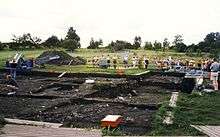
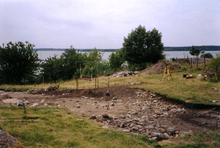
The exact location of Birka was also lost during the centuries, leading to speculation from Swedish historians. However, the island of Björkö was first claimed to have been Birka already about 1450 in the so-called "Chronicle of Sweden" (Prosaiska krönikan):
And there were three capitals in Sweden two of which were not long away from Uppsala (Vpsala). The one was called Sigtuna (siktuna) and the other Birka (birka). Birka was on an island in Lake Mälaren (mälar) that is called Björkö (birköö). The third was in Westgötaland (westergötlandh) and was called Skara (skara).[18]
In search of Birka, National Antiquarian Johan Hadorph was the first to attempt excavations on Björkö in the late 17th century.
In the late 19th century, Hjalmar Stolpe, an entomologist by education, arrived on Björkö to study fossilized insects found in amber on the island. Stolpe found very large amounts of amber on the island, which is unusual since amber is not normally found in lake Mälaren. Stolpe speculated that the island may have been an important trading post, prompting him to conduct a series of archeological excavations between 1871–95. The excavations soon indicated that a major settlement had been located on the island and eventually Stolpe spent two decades excavating the island. After Björkö came to be identified with ancient Birka, it has been assumed that the original name of Birka was simply Bierkø (sometimes spelt Bjärkö), an earlier form of Björkö.
Ownership of Björkö is today mainly in private hands, and used for farming. The settlement site, however is an archaeological site, and a museum has been built nearby for exhibition of finds (mostly replicas), models and reconstructions. It is a popular site to visit during the summer times. The complete collection of archaeological finds from the excavations on Björkö are held by The Swedish History Museum in Stockholm, and many of the artefacts are on display there.
The archaeological remains are located in the north part of Björkö and span an area of about 7 hectares (17 acres). The remains are both burial-sites and buildings, and in the south part of this area, there is also a hill fort called "Borgen" ("The Fortress"). The construction technique of the buildings is still unknown, but the main material was wood. An adjacent island holds the remains of Hovgården, an estate which housed the King's retinue during visits.
Approximately 700 people lived at Birka when it was at its largest, and about 3,000 graves have been found.[19] Its administrative center was supposedly located outside of the settlement itself, on the nearby island of Adelsö.[20]
The most recent large excavation was undertaken between 1990–95 in a region of dark earth, believed to be the site of the main settlement. Björkö is today mainly agricultural, and shipping lines carry tourists to the island, where a museum showcases a view of life during the Viking era.
See also
References
- Price, T. Douglas; Arcini, Caroline; Gustin, Ingrid; Drenzel, Leena; Kalmring, Sven (March 2018). "Isotopes and human burials at Viking Age Birka and the Mälaren region, east central Sweden". Journal of Anthropological Archaeology. 49: 19–38. doi:10.1016/j.jaa.2017.10.002.
- 2006 Encyclopædia Britannica, article "Sweden".
- http://www.cnn.com/2015/03/19/europe/sweden-viking-arabic-ring/
- 2006 Encyclopædia Britannica. Article "Birca".
- Some of them being Linköping, Köpingsvik and even Saltvik in Åland.
- Harrison, Dick, Sveriges historia -- medeltiden (Falköping, 2002), p. 51
- Lindqvist, Herman. Historien om Sverige. Islossning till kungarike. 1996. See page 165.
- Kent, Neil (2008-06-12). A Concise History of Sweden. United Kingdom: Cambridge University Press. p. 9. ISBN 978-0-521-01227-0.
- 2006 Encyclopædia Britannica. Article "Birka".
- Vita Ansgarii. Translation in English.
- The Latin word vicus which Rimbert uses about Birka can also be translated as "market place" or "village".
- Scandinavian sources omit King Olof from the list of kings that reigned in Uppsala.
- Adam of Bremen, Gesta Hammaburgensis ecclesiae pontificum Archived 2005-02-07 at the Wayback Machine, online text in Latin. Note that Scholias at the end of the text are later supplements, possibly by Adam himself or copyists. English translation of Gesta is not available in public domain, and the translation of the selected parts is by Wikipedia editors.
- Note that Adam's words "cum illa superior" may also refer to Courland discussed in Chapter IV 16 just before Estland thus meaning that Birka was not far away from Courland. Compare with Rimbert's story about an attack to Courland, Vita Ansgari Chapter XXX.
- The word iuxta can also be translated "close by".
- Assuming Birka and Björkö settlement were the same, Adam's travel instructions were latest from the 10th century when Björkö settlement still existed. Södertälje is mentioned as "Tælgia" etc in medieval sources. Gesta excluded, it is mentioned for the first time in 1281. However, it is considered possible that Södertälje was already established in the 11th century, but dating the city to be contemporary to the Björkö settlement is unlikely.
- Unni's head was taken to the Bremen Cathedral where it still today is. Date 17.9.936 is written in the lead plate attached to the saint's skull. Lindqvist, Herman. Historien om Sverige, 1992. ISBN 91-1-931502-3. See page 226.
- Prosaiska krönikan. Original text. Translation in English is by Wikipedia editors.
- Ambrosiani, Björn, Birka, in: Pulsiano, Phillip (ed.), Madieval Scandinavia. An Encyclopedia, Garland Publishing, New York / London 1993, 43
- Helle, Knut (2003). The Cambridge History of Scandinavia, Issue 1. Cambridge University Press.
External links
| Wikimedia Commons has media related to Birka. |